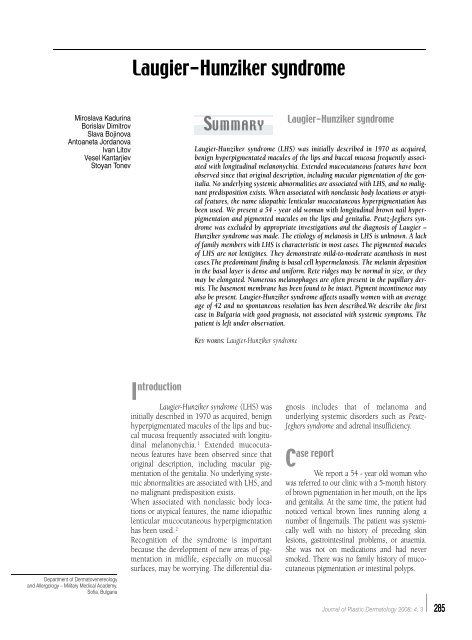N° 3 - Salute per tutti
N° 3 - Salute per tutti
N° 3 - Salute per tutti
You also want an ePaper? Increase the reach of your titles
YUMPU automatically turns print PDFs into web optimized ePapers that Google loves.
Miroslava Kadurina<br />
Borislav Dimitrov<br />
Slava Bojinova<br />
Antoaneta Jordanova<br />
Ivan Litov<br />
Vesel Kantarjiev<br />
Stoyan Tonev<br />
Department of Dermatovenereology<br />
and Allergology – Military Medical Academy,<br />
Sofia, Bulgaria<br />
Laugier-Hunziker syndrome<br />
SU M M A R Y<br />
I ntroduction<br />
Laugier-Hunziker syndrome (LHS) was<br />
initially described in 1970 as acquired, benign<br />
hy<strong>per</strong>pigmentated macules of the lips and buccal<br />
mucosa frequently associated with longitudinal<br />
melanonychia. 1 Extended mucocutaneous<br />
features have been observed since that<br />
original description, including macular pigmentation<br />
of the genitalia. No underlying systemic<br />
abnormalities are associated with LHS, and<br />
no malignant predisposition exists.<br />
When associated with nonclassic body locations<br />
or atypical features, the name idiopathic<br />
lenticular mucocutaneous hy<strong>per</strong>pigmentation<br />
has been used. 2<br />
Recognition of the syndrome is important<br />
because the development of new areas of pigmentation<br />
in midlife, especially on mucosal<br />
surfaces, may be worrying. The differential dia-<br />
Laugier-Hunziker syndrome<br />
Laugier-Hunziker syndrome (LHS) was initially described in 1970 as acquired,<br />
benign hy<strong>per</strong>pigmentated macules of the lips and buccal mucosa frequently associated<br />
with longitudinal melanonychia. Extended mucocutaneous features have been<br />
observed since that original description, including macular pigmentation of the genitalia.<br />
No underlying systemic abnormalities are associated with LHS, and no malignant<br />
predisposition exists. When associated with nonclassic body locations or atypical<br />
features, the name idiopathic lenticular mucocutaneous hy<strong>per</strong>pigmentation has<br />
been used. We present a 54 - year old woman with longitudinal brown nail hy<strong>per</strong>pigmentaion<br />
and pigmented macules on the lips and genitalia. Peutz-Jeghers syndrome<br />
was excluded by appropriate investigations and the diagnosis of Laugier –<br />
Hunziker syndrome was made. The etiology of melanosis in LHS is unknown. A lack<br />
of family members with LHS is characteristic in most cases. The pigmented macules<br />
of LHS are not lentigines. They demonstrate mild-to-moderate acanthosis in most<br />
cases.The predominant finding is basal cell hy<strong>per</strong>melanosis. The melanin deposition<br />
in the basal layer is dense and uniform. Rete ridges may be normal in size, or they<br />
may be elongated. Numerous melanophages are often present in the papillary dermis.<br />
The basement membrane has been found to be intact. Pigment incontinence may<br />
also be present. Laugier-Hunziker syndrome affects usually women with an average<br />
age of 42 and no spontaneous resolution has been described.We describe the first<br />
case in Bulgaria with good prognosis, not associated with systemic symptoms. The<br />
patient is left under observation.<br />
KEY WORDS: Laugier-Hunziker syndrome<br />
gnosis includes that of melanoma and<br />
underlying systemic disorders such as Peutz-<br />
Jeghers syndrome and adrenal insufficiency.<br />
ase report<br />
C<br />
We report a 54 - year old woman who<br />
was re f e r red to our clinic with a 5-month history<br />
of brown pigmentation in her mouth, on the lips<br />
and genitalia. At the same time, the patient had<br />
noticed vertical brown lines running along a<br />
number of fingernails. The patient was systemically<br />
well with no history of preceding skin<br />
lesions, gastrointestinal problems, or anaemia.<br />
She was not on medications and had never<br />
smoked. There was no family history of mucocutaneous<br />
pigmentation or intestinal polyps.<br />
Journal of Plastic Dermatology 2008; 4, 3 285

















